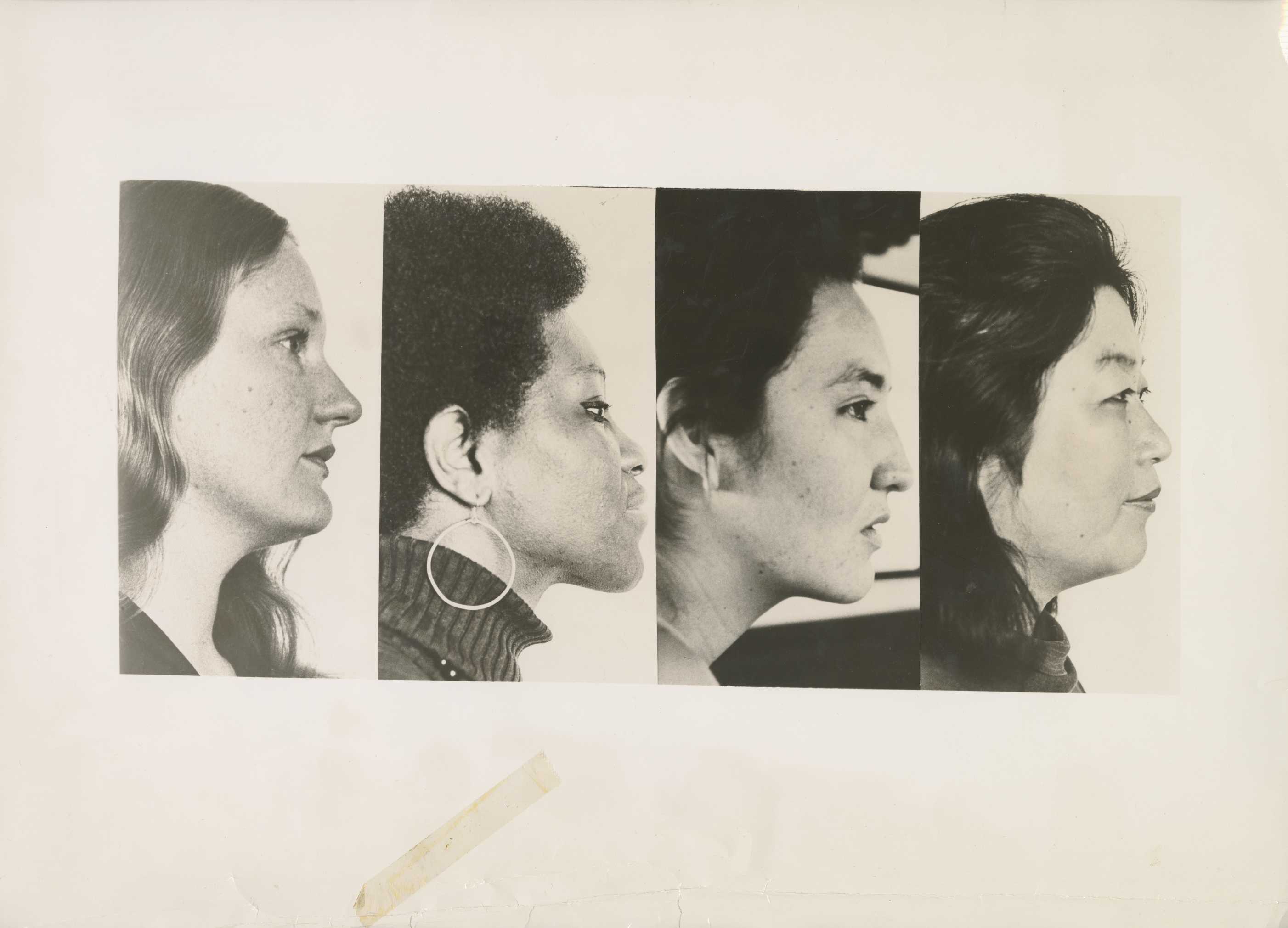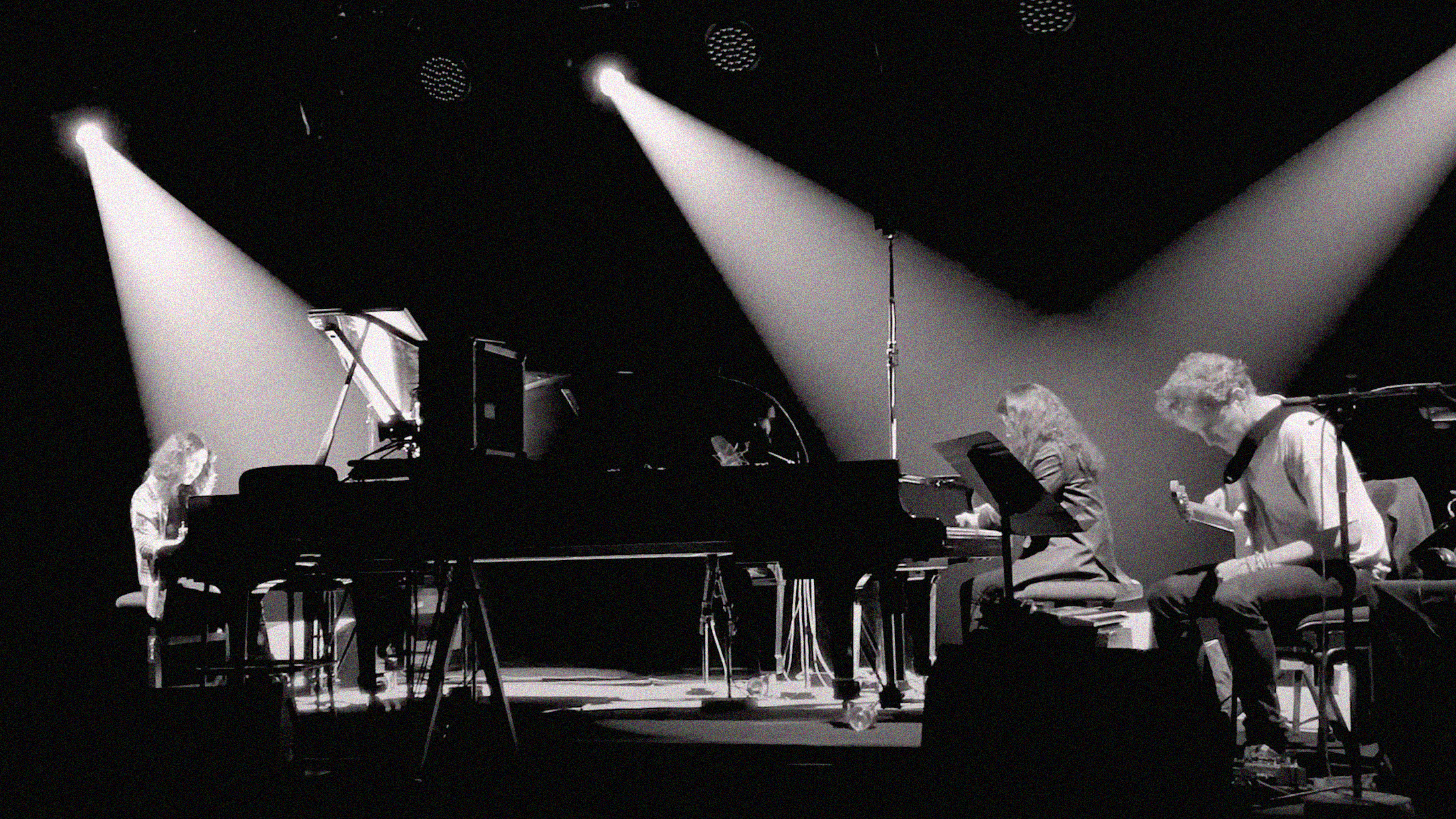
On View: March 7-April 29
The Kitchen at Westbeth (163B Bank Street, 4th Floor Loft)
Opening day hours:
Opening Reception March 7, 6–8pm
Time:
Tuesday–Saturday, 11am–6pm, Free
In 1971, Cecilia Sandoval (b. 1951), Mary Lucier (b. 1944), Shigeko Kubota (1937–2015), and Charlotte Warren (b. 1932) formed the coalition Red, White, Yellow, and Black. The group staged three multimedia concerts at The Kitchen on December 16, 1972, and April 20 and 21, 1973, housed at the time in the Mercer Arts Center, The Kitchen’s first home.
Choosing a name that deliberately reflected the cultural identities of each member, the four artists conceived the group as an inclusive platform that would highlight their individual backgrounds and experimental practices. Red, White, Yellow, and Black: 1972–73 brings together archival material, print ephemera, correspondence, oral histories, and restaged works that trace the energetic relationships of the four members of the coalition, marking the first presentation of their dematerialized work. The exhibition includes restagings of Kubota’s first foray into sculptural video from the December 1972 concert, Riverrun—Video Water Poem (1972); audio and video from Sandoval and Lucier’s collaborative performance The Occasion of Her First Dance and How She Looked (1973) from the April 1973 concerts; as well as a recording of Warren reading poems included in Black Voices (1972). The living members of the collective will gather for a public program on March 11, to reflect on the legacy of the performances and the divergent directions their lives took afterwards.
Red, White, Yellow, and Black: 1972–73 is organized by Lumi Tan, former Senior Curator, The Kitchen, and Lia Robinson, Director of Programs and Research, Shigeko Kubota Video Art Foundation, with Angelique Rosales Salgado, Curatorial Assistant, The Kitchen; Alex Waterman, Archivist, The Kitchen; and Matthew Lyons, Curator, The Kitchen. This exhibition was made possible with support from the Shigeko Kubota Video Art Foundation.
Special thanks to Norman Ballard and Reid N. Ballard from the Shigeko Kubota Video Art Foundation, and research assistance from Danni Shen, Curatorial Research Associate, CCS Bard Mentorship Program, Summer 2021.
Public Program:
Panel
Conversation: Red, White, Yellow, and Black: 1972—73
March 11, 3
pm, doors at 2:30 pm*
Free with RSVP
Artists Mary
Lucier, Cecilia Sandoval, and Charlotte Warren-Huey in
conversation with co-curators Lumi Tan and Lia
Robinson.
*Regular gallery hours will end at 1 pm
on March 11, in preparation for the program.
BIOS
Shigeko Kubota (1937–2015) was an avant-garde artist, critic, and curator whose works spanned video, sculpture, performance, and text. Initially trained in painting and sculpture, Kubota was a key member of the Tokyo and New York experimental art scenes, and throughout the 1960s participated in happenings and performance before taking up video as her primary medium in the early 1970s. Born in Niigata, Japan, Kubota graduated from the Tokyo University School of Education in 1960, with a degree in sculpture, and participated in happenings as part of the collective Hi Red Center. Disappointed by the lack of critical attention to her work in Japan, the artist decided to move to New York City in 1964, at the invitation of Fluxus impresario George Maciunas. Later dubbed Vice Chairperson of Fluxus, Kubota became a nexus between the Tokyo and New York Fluxus networks throughout the 1970s, participating in Fluxus and Avant-Garde Festivals while facilitating informal, interdisciplinary performances and object-making that blurred the distinction between art and everyday life. An early pioneer of video art, Kubota’s hybrid and thematically interconnected practice included video sculpture, which unified video and three-dimensional forms made from plywood, metal, and water to explore relationships between nature, technology, and memory—often referred to by the artist as “autobiographical objects.” In parallel, the artist also developed a wide-ranging body of video diary: single-channel, documentary-style video interwoven with text that chronicled her everyday life. Kubota served as video curator at the Anthology Film Archives (1974–1982) and exhibited her work widely throughout the 1980s and 1990s, including the 1990 Venice and Sydney Biennales. She also taught at the School of Visual Arts, New York (1978) and was artist in residence at Brown University (1981) and School of the Art Institute of Chicago (1973, 1981, 1982, and 1984). A retrospective of her work was presented at the American Museum of the Moving Image, New York, in 1991. She has held solo shows at the Whitney Museum of American Art, New York (1996); The Museum of Modern Art, New York (2021); as well as the Niigata Prefectural Museum of Modern Art, National Museum of Art, Osaka; and Museum of Contemporary Art, Tokyo (2020–22). Her work is part of a number of major collections around the world, including The Museum of Modern Art, New York; Whitney Museum of American Art; National Portrait Gallery—Smithsonian Institution; Folkwang Museum, Essen; Museum of Contemporary Art, Tokyo; National Museum of Art, Osaka; Toyama Museum of Modern Art, Toyama; and Niigata Prefectural Museum of Modern Art.
Mary Lucier has been noted for her contributions to the form of multimonitor, multichannel video installation since the early 1970s. After graduating in sculpture and literature from Brandeis University, she became involved in photography and performance while still living in the Boston area. Her work prior to her introduction to video was largely concerned with manipulation of the black-and-white image through a graphic performative process, as in the Polaroid Image Series, designed to accompany I am sitting in a room by Alvin Lucier. She also produced several live performances with the feminist video collective Red, White, Yellow, and Black (along with Shigeko Kubota, Cecilia Sandoval, and Charlotte Warren) at the original Kitchen in 1972 and '73. Since 1975 her mixed-media video works, such as Dawn Burn, Ohio at Giverny, and Wilderness have consistently explored the theme of landscape as a metaphor for loss and regeneration, while subsequent works such as Noah's Raven, House by the Water, and Floodsongs have examined ecological trauma and transformation in more obliquely narrative modes. Lucier's video installations have been shown in major museums and galleries around the world. Many now reside in important collections, among them the Whitney Museum of American Art, New York; The Museum of Modern Art, New York; the Reina Sofia, Madrid; the Stedeljik Museum, Amsterdam; the San Francisco Museum of Modern Art; ZKM, Karlsruhe, Germany; the Milwaukee Art Museum; the Columbus Museum of Art, Columbus, Ohio; the National Academy of Design, New York, among others. She has also produced a significant body of single-channel works which have been screened in museums and festivals worldwide.
Cecilia Sandoval. Born to Cecil Sandoval and Augusta Mitchell, Cecilia is a Navajo of the Kinyaa’áanii Clan—"Towering House People." Her grandfather, Frank Mitchell, was a renowned medicine man who also helped the tribe in negotiations with the US government. In 1965, she traveled with family friends to France where she attended school, graduating in 1968 from Vaucresson, an American high school in Paris. After returning to the States in 1970, she was invited by Professor David McAllister to Wesleyan University where she assisted her cousin, Douglas (Doogie) Mitchell, with the American Indian music program in the university's acclaimed World Music Department. During this time, she became acquainted with artists Alvin Lucier, Mary Lucier, Shigeko Kubota, and Nam June Paik, and performed in Paik's video production Global Groove. She was invited to participate with Kubota, Mary Lucier, and Charlotte Warren in forming the multicultural feminist performance group, Red, White, Yellow, and Black in two events at The Kitchen on Mercer Street in 1972 and 1973. Most notably, in 1973 she collaborated with Lucier on a mixed-media work titled The Occasion of her First Dance and How She Looked, based loosely on a surreal dream she described to Lucier and which they recorded on audiotape. Elements of this dream, embodied in video, slides, costumes, and text were incorporated into a performance with Lucier reciting the text while Sandoval enacted various episodes on stage and interacted with the audience. Eventually, members of the group went their separate ways and Sandoval made the decision to join the US Air Force and pursue nursing, which became her career. Following active duty in 1988, she worked at VA Medical Centers in Florida and San Diego until retiring in 2018, when she returned to the reservation in Chinle, Arizona. There she began work with various Navajo Veterans agencies, focusing on the concerns and needs of Navajo women veterans. She has been instrumental in helping to raise essential donations on behalf of tribal veterans and campaigned with others for $29 million from Tribal Headquarters to build the Navajo Veterans Nursing Home in Chinle. She is President of the Board of Directors of the Navajoland Nursing Home. She lives in Lakeside, Arizona.
Charlotte Warren-Huey, a quintessential New Yorker, was born and raised in Manhattan and Queens. She graduated with an art major from Music & Arts High School (now LaGuardia School for the Arts) and went on to obtain a Bachelor of Education and Speech at City College in Manhattan. This was followed by her first Masters in Speech Arts/Audiology at Hunter College. During this period she also taught a course in Creative Dramatics for Parents & Children at City and Hunter College. She lived in Belgium for seven years where her husband, Charles, went to medical school at the University of Louvain. In addition to traveling abroad during these years, she wrote articles for French newspapers and magazines (ESPRIT) where she met other writers of the same magazine (Simone du Beauvoir, Jean Paul Sartre), and tutored English for foreign students going to the US to study. Upon their return to the States, they first lived in Rochester, New York (where her husband did his internship). During that period she chaired the Speech Department at West High School. She also founded a Performing Arts Center before moving to Buffalo, where she directed plays at the Studio Arena Theatre. Warren-Huey taught at Francis Lewis High School in Queens until 1979, when she moved to Springfield Gardens High School as a college advisor/guidance counselor. In the interim, she received her second masters in Counseling at C.W. Post. She worked as an adjunct professor at the University of Massachusetts at Amherst, and L.I. University. She also did freelance journalism for women’s magazines and papers (New York Women’s Week). Of all her accomplishments, Charlotte is most proud of her work with the group, Red, White, Yellow, and Black, where she met and engaged with Shigeko Kubota, Cecilia Sandoval, and Mary Lucier. As each performed in their own medium, something that also exemplified their individual ethnic group, Charlotte’s participation was readings from the works of Black poets and other Black artists of the time. The performance was at the original Kitchen at 240 Mercer Street.
FUNDING SUPPORT & CREDITS
Red, White, Yellow, and Black: 1972—73 is made possible with generous support from annual grants from The Amphion Foundation, Inc., Arison Art Foundation, Bloomberg Philanthropies, The Aaron Copland Fund for Music, The Cowles Charitable Trust, Joseph and Joan Cullman Foundation for the Arts, Inc., The Willem de Kooning Foundation, Helen Frankenthaler Foundation, Howard Gilman Foundation, The Harkness Foundation for Dance, Marta Heflin Foundation, Lambent Foundation, Fund of Tides Foundation, Mertz Gilmore Foundation, Open Society Foundation, The Jerome Robbins Foundation, The Fan Fox and Leslie R. Samuels Foundation, Simons Foundation, and Teiger Foundation; and in part by public funds from New York City Department of Cultural Affairs in partnership with the City Council and New York State Council on the Arts with the support of the Office of the Governor and the New York State Legislature.
Season programming is made possible in part with support from The Kitchen’s Board of Directors and The Kitchen Leadership Fund. Learn more about the Leadership Fund.

